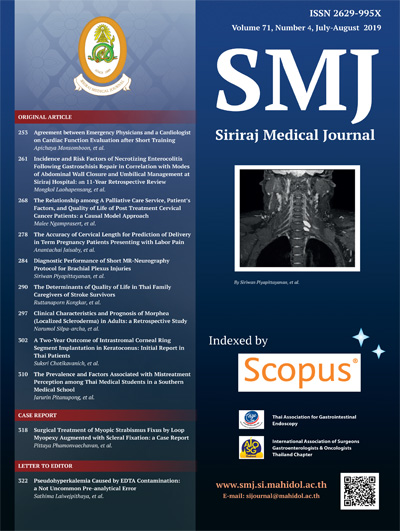Incidence and Risk Factors of Necrotizing Enterocolitis Following Gastroschisis Repair in Correlation with Modes of Abdominal Wall Closure and Umbilical Management at Siriraj Hospital: an 11-Year Retrospective Review
Keywords:
NEC; gastroschisis; umbilical preservationAbstract
Objective: We investigated the correlation between umbilical management and NEC in infants with gastroschisis as well as the incidence and potential risk factors of NEC in patients with gastroschisis at Siriraj Hospital from 2005 to 2016.
Methods: A retrospective chart review was conducted of patients with gastroschisis who were surgically repaired at Siriraj Hospital from January 2005 to January 2016. The baseline characteristics, umbilical management, and short-term outcomes were analyzed in relation to NEC complications to determine the associated correlations and potential risk factors.
Results: Overall, 106 patients were enrolled. The incidence of NEC following gastroschisis repair was 16% (17/106). Umbilical preservation was a significant potential risk factor for NEC (p = 0.009; hazard ratio = 5.14; 95% CI = 1.51-17.42). There were no significant differences between the NEC and non-NEC group for gender, median Apgar
scores, gestational ages, and birth weight. The short-term outcomes were significantly higher for the NEC than the non-NEC group, with a time to first oral feeding of 15 vs. 9 days (p = 0.006), duration of total parenteral nutrition, 22 vs. 12 days (p < 0.001), and length of stay, 32 vs. 23 days (p = 0.01) respectively.
Conclusion: Umbilical preservation following gastroschisis repair was associated with a higher incidence of NEC, even in term infants. Thus, NEC should be carefully monitored after abdominal fascial closure with umbilical preservation.
Downloads
Published
How to Cite
Issue
Section
License
Authors who publish with this journal agree to the following conditions:
Copyright Transfer
In submitting a manuscript, the authors acknowledge that the work will become the copyrighted property of Siriraj Medical Journal upon publication.
License
Articles are licensed under a Creative Commons Attribution-NonCommercial-NoDerivatives 4.0 International License (CC BY-NC-ND 4.0). This license allows for the sharing of the work for non-commercial purposes with proper attribution to the authors and the journal. However, it does not permit modifications or the creation of derivative works.
Sharing and Access
Authors are encouraged to share their article on their personal or institutional websites and through other non-commercial platforms. Doing so can increase readership and citations.











